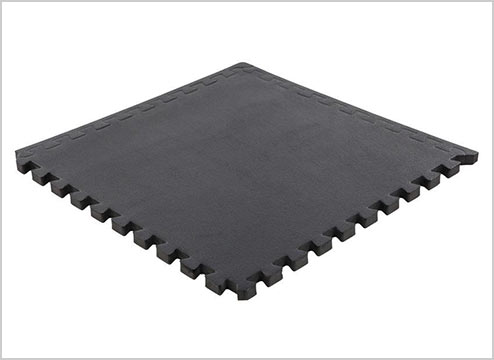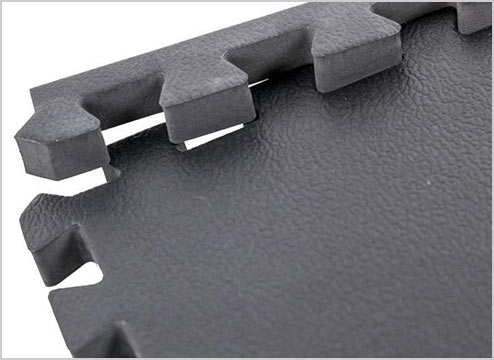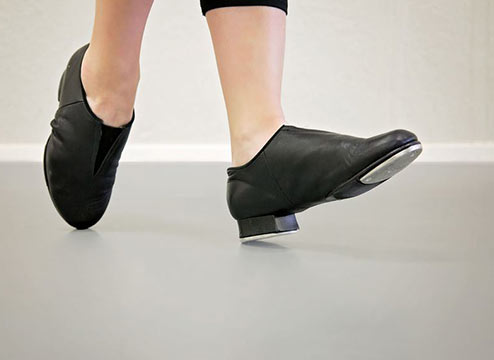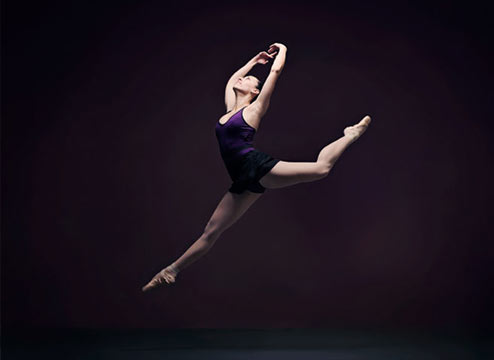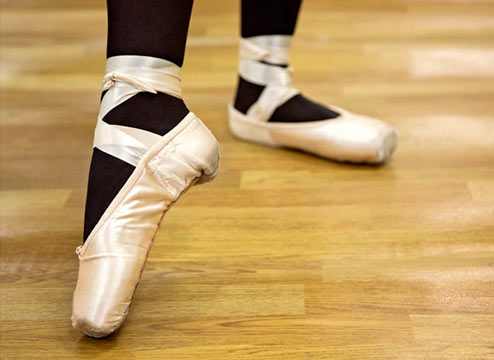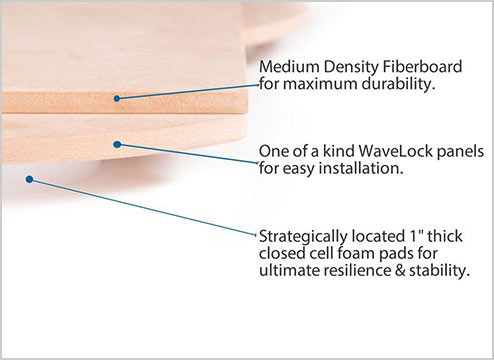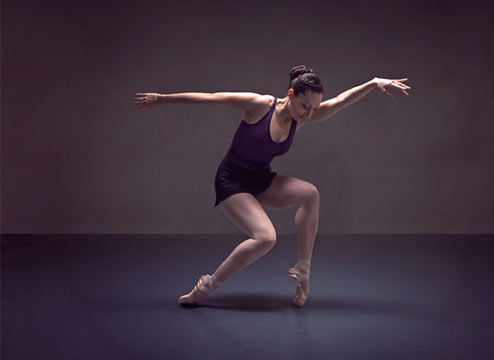Dance Subfloors Buying Guide
Discover why a dance subfloor is essential for dancers of all styles and levels. Find your perfect sprung subfloor or foam subfloor and create your dream dance space easily without breaking the bank account.
Dance is many things, but low impact isn't one of them.
As a dancer, you know how hard the landings from lifts, jumps, and floor work can be on your joints. If you've ever danced on Marley floors laid directly over cold, unforgiving concrete, you know what I mean and you understand the need for a sturdy, supportive subfloor.
Don't worry; when I say "supportive," I don't mean it's going to sink underneath you. Dance flooring requires a delicate balance of support to ensure you have effortless landings without rolling an ankle.
The good news is that we have options for just about every level, from beginner to professional. Different locations and styles have different needs. While a professional company or advanced ballet studio typically requires a fully sprung dance subfloor, home practice and young dancers can get away with a high-density foam option.
Let's take a look and figure out which option is best for you.
Dance is many things, but low impact isn't one of them.
As a dancer, you know how hard the landings from lifts, jumps, and floor work can be on your joints. If you've ever danced on Marley floors laid directly over cold, unforgiving concrete, you know what I mean and you understand the need for a sturdy, supportive subfloor.
Don't worry; when I say "supportive," I don't mean it's going to sink underneath you. Dance flooring requires a delicate balance of support to ensure you have effortless landings without rolling an ankle.
The good news is that we have options for just about every level, from beginner to professional. Different locations and styles have different needs. While a professional company or advanced ballet studio typically requires a fully sprung dance subfloor, home practice and young dancers can get away with a high-density foam option.
Let's take a look and figure out which option is best for you.
Foam Dance Subfloors
If you're creating a home practice space or even a beginner dance studio, you have a lot of super affordable options when it comes to your subfloor.
Home Dance Subfloor Tiles
For a home practice space, we recommend starting with Home Dance Subfloor tiles. These tiles are made from premium, high-density foam that absorbs the shock and impact from your petite allegro without that sinking feeling you might typically associate with foam.
This is tough foam. Hardcore foam.
These babies are perfect for at-home barre and center work, practicing jazz pirouettes and leaps and contemporary floor work. It really can do just about everything for beginning dancers.
We do not, however, recommend our Home Dance Subfloor Tiles for advanced pointe work. With pointe, you're dancing on such a small surface area, you just need something a little sturdier for extra safety.
This is tough foam. Hardcore foam.
These babies are perfect for at-home barre and center work, practicing jazz pirouettes and leaps and contemporary floor work. It really can do just about everything for beginning dancers.
We do not, however, recommend our Home Dance Subfloor Tiles for advanced pointe work. With pointe, you're dancing on such a small surface area, you just need something a little sturdier for extra safety.
Premium Dance Subfloor Kits
This is a step up! The combination of affordable foam subflooring with a hard plastic top layer to ensure maximum stability.
With our Premium Dance Subfloor Kits, you can practice everything from tendues to fouettes en pointe. It can handle your petite allegro, grande allegro and even challenging partner lifts. They are also perfect for tap, due to the increased sound quality with the hard top surface.
The top, ultra-sturdy plastic layer makes this subfloor an excellent option for all levels and most styles of dance. It's also an excellent option for touring companies and studios that don't have the option to use traditional sprung subflooring.
And, it's super affordable! All of the winning.
With our Premium Dance Subfloor Kits, you can practice everything from tendues to fouettes en pointe. It can handle your petite allegro, grande allegro and even challenging partner lifts. They are also perfect for tap, due to the increased sound quality with the hard top surface.
The top, ultra-sturdy plastic layer makes this subfloor an excellent option for all levels and most styles of dance. It's also an excellent option for touring companies and studios that don't have the option to use traditional sprung subflooring.
And, it's super affordable! All of the winning.
Pros of Foam Dance Subfloors
- Perfect for homes: If you're creating a home dance studio or practice space, there is no better subfloor option than our foam dance subfloors.
- Portable and great for travel: While you can install these permanently, they are incredibly lightweight and easy to transport.
- Options for every level: You can choose from beginner-and-budget-friendly Home Dance Subfloor Tiles, or go the premium route for advanced movements. Either way, there is something for you.
- Comfort and safety: Say no to dancing on hard concrete floors. It feels awful and it increases your likelihood of injury.
- Easy to install: Seriously, the easiest.
- Price: Compared to traditional sprung subflooring, foam dance subfloors are a super affordable option.
Cons of Foam Dance Subfloors
- Some options are less versatile. While they work for many styles, our foam dance subfloors are not approved for Flamenco, ballroom and Irish dancing. Additionally, the Home Dance Subfloor Tiles are not suitable for advanced pointe work.
- They have less shock absorption than sprung subfloors. These do help, but the sprung dance subfloors have a bit more of an advanced design to support professional-level dancers.
- They're not as well known in the professional world. If you own a professional studio or company, dancers will ask "Do you have a sprung subfloor?" The foam subfloors are great, but they don't have the recognition that sprung subfloors have.
Foam Dance Subfloor Durability / Longevity
It is very rare for a studio owner to have to replace their dance subfloors. They are truly built to last and because the dance flooring covers them, they aren’t getting the wear and tear of a normal floor.
Usually, these subfloors can last you the length of your dance career and beyond.
Usually, these subfloors can last you the length of your dance career and beyond.
Foam Dance Subfloor Installation
Installing your Foam Dance Subfloor is a super easy DIY project. Foam tiles easily lock together like puzzle pieces. They are also super light and easy to maneuver.
Interlock your tiles together to form the space you need and you're done. Yes, it's really that easy.
If you're using a plastic top layer for our premium kits, you simply lay these on top of your foam with no tape or glue necessary. These plastic tiles have interlocking loops. They can require a little effort to lock them in place, but they are still incredibly easy. For safety, feel free to use a plastic tile cutter to remove the loops from the edges of your floor.
Once your Foam Dance Subfloor is ready, lay your Marley on top following the manufacturer instructions.
Interlock your tiles together to form the space you need and you're done. Yes, it's really that easy.
If you're using a plastic top layer for our premium kits, you simply lay these on top of your foam with no tape or glue necessary. These plastic tiles have interlocking loops. They can require a little effort to lock them in place, but they are still incredibly easy. For safety, feel free to use a plastic tile cutter to remove the loops from the edges of your floor.
Once your Foam Dance Subfloor is ready, lay your Marley on top following the manufacturer instructions.
Sprung Dance Subfloors
Our sprung dance subfloor was developed and tested by professional dancers, specially engineered to give dancers the perfect combination of resiliency and stability. The resiliency, or bounce, allows the floor to gently and almost unnoticeably give under the pressure of your foot, gently absorbing and dispersing the impact.
Marley laid over a hard concrete floor with no sprung subfloor has zero give. When you land on concrete, the shock of your landing travels back through your body rather than through the give of the floor.
Traditional dance flooring, such as Marley, has no shock absorption on its own. The best way to get that is through sprung subfloors.
These sprung dance floors combine medium-density fiberboard (MDF) with 1”-closed-cell foam pads. The pads are strategically placed to give the ultimate give and support.
Marley laid over a hard concrete floor with no sprung subfloor has zero give. When you land on concrete, the shock of your landing travels back through your body rather than through the give of the floor.
Traditional dance flooring, such as Marley, has no shock absorption on its own. The best way to get that is through sprung subfloors.
These sprung dance floors combine medium-density fiberboard (MDF) with 1”-closed-cell foam pads. The pads are strategically placed to give the ultimate give and support.
Why Choose Sprung Dance Subfloors
Okay, so you’ve probably heard the term “sprung floor” before. Any studio with sprung dance floors likes to tout that little fact with pride because, well, it’s awesome!
Sprung subfloors are the dancer’s best friend!
It’s not like the floors you see in cheerleading where they legitimately propel the athlete in the air. These are much more of a subtle spring. Their purpose isn’t to help you jump higher but to dissipate some of the impact when you land.
You’ll also hear them referred to as a floating floor, but that can mean a lot of things and isn’t necessarily specific to sprung floors.
Now, when I tell you that you need sprung subflooring, I am referring to advanced studios and professional spaces, not home practice spaces. Home practices spaces work well with the foam subfloors mentioned above.
I wanted to explain this correctly, so I started Googling the mathematical equation for the amount of weight forced onto your joints as you land. And then I realized that the chances that you’d be interested in the physics of this were probably slim to none.
So instead, I will tell you this: You land with a lot more weight and force on your joints than just your body weight. And, no matter how small you are, it’s a lot of pressure on your body and can cause or exacerbate injuries.
We interviewed a dancer who mentioned that she suffered shoulder injuries from rehearsing in a studio without sprung subfloors. Yes, shoulder injuries. I know, you’d think it would be your legs/ankles/feet that you’re landing on, but this impact affects your entire body.
This is why professional settings 100% need a sprung dance floor.
Sprung subfloors are the dancer’s best friend!
It’s not like the floors you see in cheerleading where they legitimately propel the athlete in the air. These are much more of a subtle spring. Their purpose isn’t to help you jump higher but to dissipate some of the impact when you land.
You’ll also hear them referred to as a floating floor, but that can mean a lot of things and isn’t necessarily specific to sprung floors.
Now, when I tell you that you need sprung subflooring, I am referring to advanced studios and professional spaces, not home practice spaces. Home practices spaces work well with the foam subfloors mentioned above.
I wanted to explain this correctly, so I started Googling the mathematical equation for the amount of weight forced onto your joints as you land. And then I realized that the chances that you’d be interested in the physics of this were probably slim to none.
So instead, I will tell you this: You land with a lot more weight and force on your joints than just your body weight. And, no matter how small you are, it’s a lot of pressure on your body and can cause or exacerbate injuries.
We interviewed a dancer who mentioned that she suffered shoulder injuries from rehearsing in a studio without sprung subfloors. Yes, shoulder injuries. I know, you’d think it would be your legs/ankles/feet that you’re landing on, but this impact affects your entire body.
This is why professional settings 100% need a sprung dance floor.
Pros of Sprung Subfloors
I mean, I’ve already talked these babies up a lot. But here are the main bullet points.
- Injury prevention: While sprung dance floors won’t prevent all injuries, they will absolutely help keep your dancers healthier.
- Comfort: Although injury prevention is most important, comfort for your dancers is a big added bonus. Imagine running on a soft trail as opposed to hard concrete. It truly feels better.
- Career longevity: Less impact + fewer injuries = longer dance career.
- Attracts dancers: Dancers want to feel good and stay healthy. Many of them look for this in studios and company rehearsal spaces.
- Easy to install: You can easily do it yourself and the tiles are pretty large, so it won’t take you a million years.
Cons of Sprung Subfloors
They’re wonderful, but nothing can be perfect, except for you. You are perfect.
- Price: Yeah, yeah….it’s an added expense. It can be a little more of a financial challenge.
Sprung Subfloor Durability / Longevity
It is very rare for a studio owner to have to replace sprung subfloors. They are truly built to last and because they are covered by the dance flooring, they aren’t getting the wear and tear of a normal floor.
Usually, these subfloors can last you the length of your dance career and beyond.
Usually, these subfloors can last you the length of your dance career and beyond.
Sprung Subfloor Installation
Their unique WaveLock technology makes installation a breeze for these sprung dance subfloors. Simply lock each piece together (they’re 3.5’ x 3.5’ each) and then lock in perimeter pieces - they’re what lock the entire floor together and keep it tight and sturdy.
You can bolt down your perimeter pieces to concrete or wood and easily remove them and take them with you to a new venue. In fact, you can install this sprung dance floor permanently, semi-permanently, or temporarily. It’s versatile and ready to go wherever you go!
You can bolt down your perimeter pieces to concrete or wood and easily remove them and take them with you to a new venue. In fact, you can install this sprung dance floor permanently, semi-permanently, or temporarily. It’s versatile and ready to go wherever you go!
Dance Styles That Need Dance Subfloors
Honestly, every dance style can benefit from dance subfloors. They are most common with ballet, jazz and contemporary, particularly with professional companies and competitive studios.
However, any and all dancers will benefit from these subfloors, regardless of style.
However, any and all dancers will benefit from these subfloors, regardless of style.
Best Flooring Options Above Dance Subfloors
You don’t want to go to the trouble of choosing the best dance subfloor only to get some janky flooring to go on top of it. And you don’t want to dance directly on the sprung subfloor with nothing in between.
The best choice (for most styles) is a vinyl Marley flooring roll. Other styles that require a hard surface dance floor do great with dance tiles or traditional wood.
The best choice (for most styles) is a vinyl Marley flooring roll. Other styles that require a hard surface dance floor do great with dance tiles or traditional wood.
Ready to get started?


